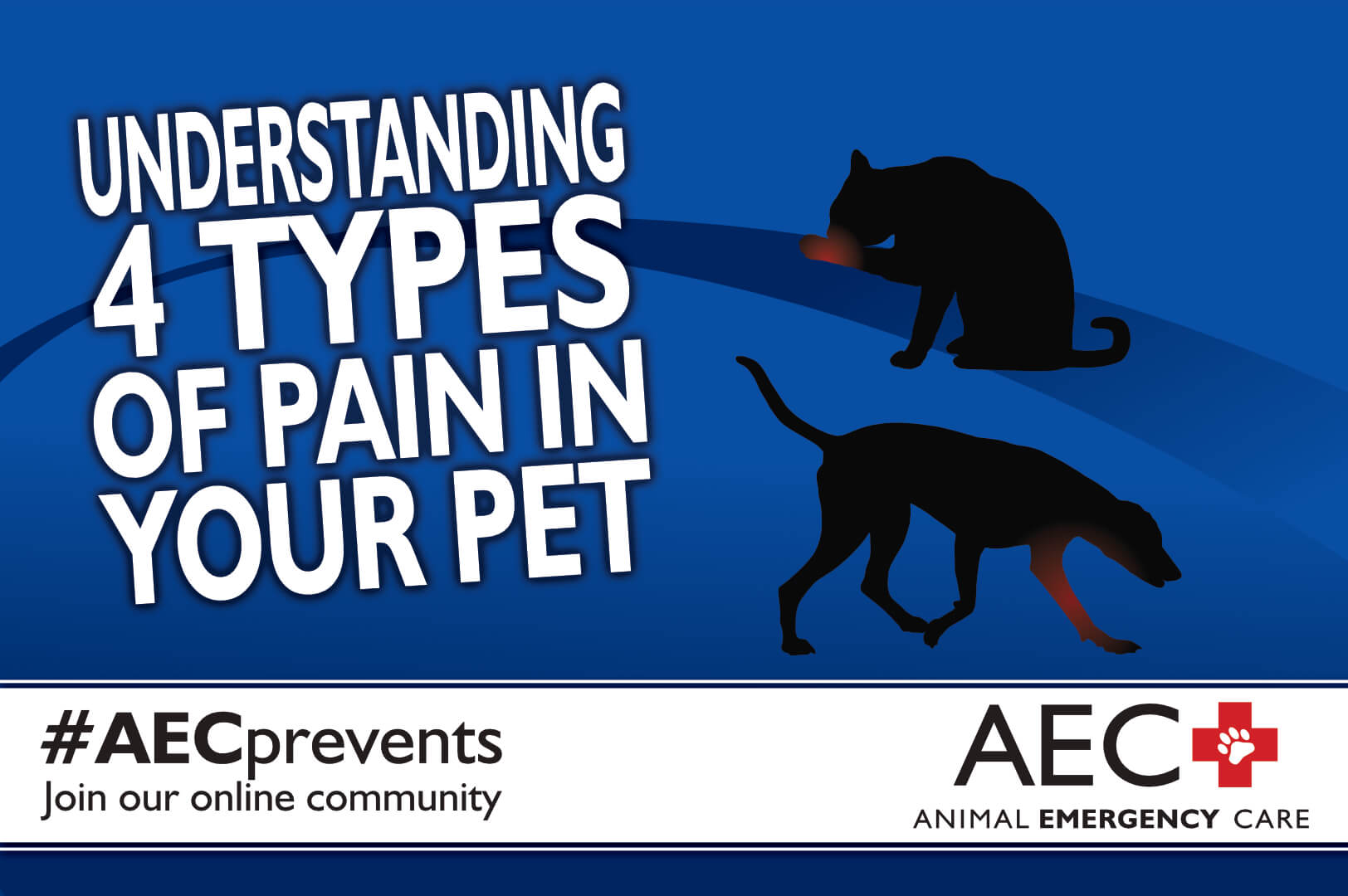Pets, like people, thrive with a consistent daily routine, proper nutrition, regular exercise, and preventive medical care. The human-animal bond is a vital part of caring for a pet, and it can be heartbreaking if you suspect your pet is experiencing pain. Recognizing signs of pain can be challenging because pets are skilled at hiding illness, injury, or other painful problems. Understanding your pet’s type of pain is the first step toward helping alleviate their discomfort. Our Animal Emergency Care team describes the four common pet pain types and how to recognize the signs.
#1: Acute pain in pets
No pet owner wants their furry pal to experience pain. At the same time, pain is important and serves as an alert to protect an injured area and prevent further injury. Acute pain is a recent, noticeable response to something that happens suddenly, such as a cut paw during a run at the park or burned whiskers from a curious nose investigating a sizzling steak. Other common causes of acute pain include trauma, bruising, crushing injuries, cuts, or other body injuries. Postsurgical or procedural pain also is considered acute. Acute pain is often sharp, throbbing, or aching and usually improves within three days after the traumatic event or surgery. However, without treatment, acute pain can become chronic. Common signs of acute pain may include:
- Behavior changes such as hiding or resisting handling
- Limping
- Guarding a body part such as paw or tail
- Licking, biting, or rubbing the affected area
#2: Chronic pain in pets
Chronic or persistent pain can be stressful to pets and decreases their overall quality of life and wellness. Chronic pain is typically a dull, ongoing pain. It does not serve a protective purpose, unlike acute pain. Recognizing chronic pain can be tricky for pet owners because subtle signs may be similar to normal age-related changes like slowing down or sleeping more. Additionally, many pets who experience chronic pain will continue to participate in normal activities such as eating or playing. But if your pet has chronic, painful dental disease, it may take them longer to finish a meal or they may resist hard food treats and continue to eat canned food. Osteoarthritis, or joint disease, is a common source of chronic pain for pets and more than 20% of dogs are affected. Pets with this type of pain may have changes in posture or stiff limbs after sleeping or napping. Other chronic pain signs may include:
- Decreased appetite
- Changes in breathing patterns or increased panting when at rest
- Changes in movement or posture
- Decreased interest in long walks or games of fetch
- Behavior changes such as irritability
#3: Cancer pain in pets
Cancer pain can be acute and chronic. New fast-growing masses are considered acutely painful because they can invade surrounding tissues, nerves, or bones. A primary bone tumor is the most common pain-causing cancer, but any type of tumor can be associated with pain. Acute pain also may be caused by cancer surgery or treatments such as radiation therapy. As the cancer progresses, your pet could experience chronic pain from long-term effects of the disease like tissue inflammation or secondary infections. It can be challenging for pet owners to recognize cancer signs because the tumor may not be visible. Bring your pet in for a veterinary examination if they show the following signs which could be associated with cancer pain:
- Decreased appetite
- Lethargy
- Weight loss
- Wounds that do not heal
- Limping that occurs without an injury
- Abdominal swelling
- Swollen joints
- Abnormal bleeding
#4: Neuropathic pain in pets
Neuropathic pain can occur from an injury or disease that affects a pet’s nerves or nerve function within the spinal cord. Nerve damage or inflammation often results in a tingling sensation that is difficult to diagnose in pets because they cannot communicate a pins-and-needles sensation in their limbs. Neuropathic pain is often chronic and associated with mobility problems, similar to pets who have osteoarthritis. Common signs of neuropathic pain may include:
- Limping or dragging of limbs
- Shaking or twitching skin
- Muscle atrophy
- Inappropriate elimination
- Decreased appetite
- Vocalization
Call your family veterinarian if you suspect your pet is in pain. If your pet is showing signs of pain after hours, call Animal Emergency Care. #AECprevents
Sources:
https://www.merckvetmanual.com/special-pet-topics/pain-management/types-of-pain
https://www.zoetispetcare.com/blog/article/chronic-acute-pain-dogs
https://www.petmd.com/dog/conditions/neurological/c_dg_neuropathic_pain
https://www.dvm360.com/view/understanding-and-recognizing-cancer-pain-dogs-and-cats
https://www.merckvetmanual.com/special-pet-topics/cancer-and-tumors/caring-for-a-pet-with-cancer


